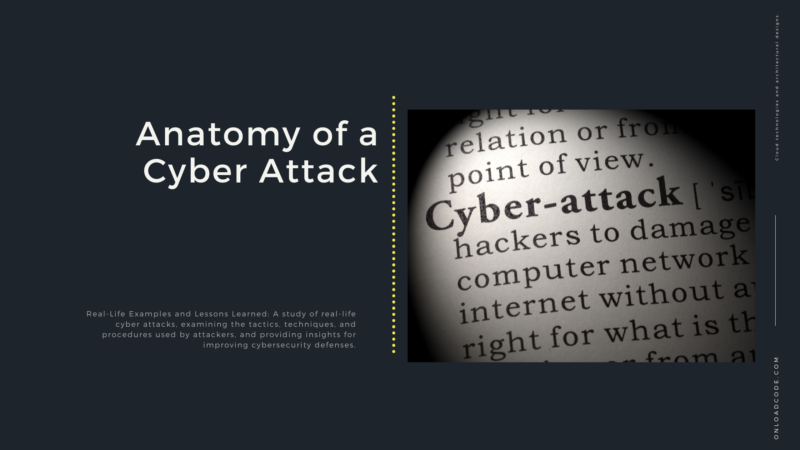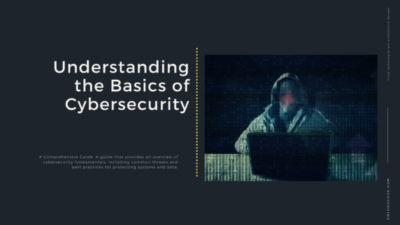This article will explore real-life examples of cyber attacks, including how they were executed and the impact they had. It will provide insights into the anatomy of these attacks and the lessons that can be learned to better protect against future incidents.
This is the 3rd article on the Cybersecurity: Securing the Digital Landscape series. In this article, we are discussing the Anatomy of a Cyber Attack in Cybersecurity.
Introduction
The prevalence and impact of cyber attacks
Cyber attacks have become increasingly common in today’s digital age, and their impact can be devastating for both individuals and organizations. These attacks can come in various forms, including malware, ransomware, phishing, and social engineering, to name a few. The consequences of a successful cyber attack can range from financial loss to damage to a company’s reputation, and even loss of life in some cases. In this article, we will explore real-life examples of cyber attacks and the lessons that can be learned from them.
The Anatomy of a Cyber Attack
A cyber attack can be broken down into several stages that a hacker may take to breach a target’s defenses and carry out their objectives. The first stage is reconnaissance, where the attacker gathers information about their target to identify potential vulnerabilities and plan their attack. This can include scanning for open ports, identifying software versions, and searching for any known weaknesses.
The next stage is gaining access, which involves finding and exploiting a vulnerability in the target’s network or system. This can be accomplished through methods such as brute force attacks, social engineering, or exploiting unpatched software vulnerabilities.
Once the attacker has gained access, they may move to escalate their privileges, allowing them to gain greater control over the target’s systems and data. This can involve stealing user credentials, exploiting misconfigured security settings, or using malware to gain control of systems.
With escalated privileges, the attacker can then carry out their objectives, which may include stealing sensitive data, installing malware, or disrupting services. They may also attempt to cover their tracks to avoid detection, by deleting logs or modifying system settings to make it more difficult for defenders to identify the attack.
Understanding the tactics and techniques used by attackers is crucial for defending against cyber attacks. Attackers may use a variety of methods to evade detection and carry out their objectives, such as using encryption to hide their communications, or using legitimate tools and software in unintended ways to bypass security controls.
By understanding the anatomy of a cyber attack, organizations can better prepare for and defend against potential threats. This includes implementing appropriate security controls, such as access controls and intrusion detection systems, as well as regularly reviewing and updating security policies and procedures.
Real-Life Examples of Cyber Attacks
Cyber attacks can happen to any organization or individual, regardless of their size or industry. In recent years, there have been numerous high-profile cyber attacks that have caused significant financial losses, damaged reputations, and even put people’s lives at risk.
One such attack was the 2017 WannaCry ransomware attack, which affected more than 200,000 computers across 150 countries. The ransomware exploited a vulnerability in the Windows operating system, encrypting users’ files and demanding a ransom in exchange for the decryption key. The attack affected hospitals, businesses, and government agencies, causing disruptions and financial losses.
Another notable attack was the 2013 Target data breach, which compromised the personal and financial information of over 110 million customers. The attackers gained access to Target’s systems through a third-party HVAC vendor, highlighting the importance of third-party risk management.
The 2014 Sony Pictures hack is another example of a high-profile cyber attack. The attackers, who were later identified as North Korean operatives, stole and released sensitive information, including unreleased movies and confidential employee data. The attack led to significant financial losses, damaged reputation, and even geopolitical tensions.
These are just a few examples of the many cyber attacks that have occurred in recent years. They demonstrate the devastating impact that cyber attacks can have on organizations and individuals alike. It’s crucial to learn from these examples and take steps to protect against future attacks.
Adding images to this section can be helpful to visually show the impact of the attacks and the severity of the consequences. For example, including a graph or chart that displays the financial losses due to cyber attacks can be effective in emphasizing the importance of cybersecurity measures.
Lessons Learned from Cyber Attacks
As cyber attacks become increasingly common and sophisticated, it’s important to understand the potential consequences of a successful attack and to implement best practices for prevention and response. Here are some lessons that can be learned from recent cyber attacks:
The Consequences of a Successful Attack
- Data theft and loss: Cyber attacks can result in the loss or theft of sensitive data, including personal information, financial records, and confidential business data.
- Financial damage: Cyber attacks can cause significant financial damage to individuals and organizations, including lost revenue, legal fees, and costs associated with repairing and restoring systems.
- Reputational damage: A cyber attack can also cause reputational damage, particularly if sensitive information is leaked or if customers lose trust in the affected organization.
- Operational disruption: Cyber attacks can disrupt business operations, leading to loss of productivity and revenue.
Best Practices for Prevention and Response
- Regular security assessments: Organizations should conduct regular security assessments to identify vulnerabilities and ensure that security controls are in place and working effectively.
- Employee training: Employee training is essential for preventing cyber attacks, as many attacks are the result of human error. Training should cover topics such as password hygiene, email security, and phishing awareness.
- Strong passwords: Passwords should be complex, unique, and changed regularly to prevent unauthorized access to systems and data.
- Multi-factor authentication: Multi-factor authentication adds an extra layer of security by requiring users to provide additional information beyond a password to access systems and data.
- Backup and recovery: Regularly backing up data is essential for recovery in the event of a cyber attack. Backups should be stored in a secure location and tested regularly to ensure that they can be restored quickly and effectively.
- Incident response plan: Organizations should have a well-defined incident response plan in place to guide their response in the event of a cyber attack. This should include procedures for identifying and containing the attack, notifying stakeholders, and restoring systems and data.
- Collaboration: Collaboration between different departments and organizations is essential for effective cyber security. This includes collaboration between IT, legal, and public relations teams within an organization, as well as collaboration between different organizations in sharing threat intelligence and responding to attacks.
By learning from real-life examples of cyber attacks and implementing best practices for prevention and response, organizations can better protect themselves and their customers from the damaging effects of cyber crime.
Preparing for a Cyber Attack
- Assessing your organization’s cybersecurity readiness
- Developing an incident response plan
- Regularly testing and updating your defenses
- Investing in cybersecurity insurance
As cyber attacks continue to increase in frequency and sophistication, it’s important for organizations to take proactive steps to protect themselves. Assessing your organization’s cybersecurity readiness is the first step in this process. This involves identifying your critical assets and evaluating your current security posture.
Once you have a clear understanding of your organization’s cybersecurity risks and vulnerabilities, it’s important to develop an incident response plan. This plan should outline the steps that your organization will take in the event of a cyber attack, including who is responsible for what tasks and how communication will be handled.
Regularly testing and updating your defenses is also critical for staying ahead of evolving cyber threats. This includes conducting regular vulnerability scans and penetration testing, as well as staying up to date with software and security patch updates.
Finally, investing in cybersecurity insurance can help mitigate the financial impact of a successful cyber attack. Cybersecurity insurance policies can provide coverage for things like data recovery, business interruption, and legal fees associated with cyber incidents.
It’s important to note that cybersecurity is not a one-time effort, but an ongoing process that requires constant attention and investment. By taking proactive steps to assess your organization’s cybersecurity readiness, develop an incident response plan, regularly test and update your defenses, and invest in cybersecurity insurance, you can better protect your organization from the potentially devastating consequences of a successful cyber attack.
Protecting Against Cyber Attacks
In today’s world, where cyber attacks have become increasingly sophisticated, it’s critical to have a robust cybersecurity strategy in place to protect your organization. Here are some proactive steps you can take to enhance your cybersecurity posture:
- Conduct regular security assessments: Regular security assessments help identify vulnerabilities and security gaps in your organization’s infrastructure, policies, and procedures. These assessments can be performed by an internal team or an external cybersecurity vendor.
- Implement a strong password policy: Weak passwords are one of the most common entry points for cybercriminals. Implementing a strong password policy that requires complex, unique passwords and regular password changes can help reduce the risk of unauthorized access.
- Deploy firewalls and antivirus software: Firewalls and antivirus software can help block malicious traffic and prevent malware from infecting your systems. Make sure to keep these tools up to date to ensure they are effective against the latest threats.
- Encrypt sensitive data: Encryption is a critical component of protecting sensitive data. Implement encryption protocols for data at rest and in transit to ensure that even if data is stolen, it cannot be read by unauthorized individuals.
- Train your employees: Human error is often the weakest link in an organization’s cybersecurity defenses. Regular training and awareness programs can help educate employees on how to identify and avoid potential cyber threats.
In addition to these proactive measures, it’s also essential to have an incident response plan in place to respond quickly and effectively to a cyber attack.
An incident response plan should include:
- A clear escalation path: A clear escalation path ensures that all incidents are reported and escalated to the appropriate individuals or teams in a timely manner.
- Response procedures: Clearly defined response procedures ensure that the incident response team takes the appropriate steps to contain, investigate, and resolve the incident.
- Communication protocols: Effective communication is critical during a cyber attack. Establish clear communication protocols to ensure that all stakeholders are informed of the incident and the organization’s response.
- Backup and recovery plans: In the event of a cyber attack, having a backup and recovery plan in place can help restore systems and data quickly and efficiently.
By taking proactive steps to enhance your cybersecurity posture and having an incident response plan in place, you can help minimize the impact of a cyber attack and protect your organization’s sensitive data and critical systems.
Conclusion
In today’s digital age, the threat of cyber attacks is constant and ever-evolving. With the increasing dependence on technology and the internet, cyber attacks have become more frequent, sophisticated, and damaging. From stealing sensitive data to disrupting critical infrastructure, cyber attacks can have severe consequences on individuals, businesses, and even nations.
In this article, we have examined the anatomy of a cyber attack, including the different stages involved and the tactics and techniques used by attackers. We have also explored real-life examples of cyber attacks in different industries and sectors, highlighting the devastating impact they can have on organizations and individuals.
Furthermore, we have discussed the lessons learned from these cyber attacks, including the importance of having a robust cybersecurity posture and an incident response plan in place. By being proactive in enhancing our cybersecurity defenses and planning for the worst, we can better protect ourselves against cyber attacks and minimize their impact.
In conclusion, the threat of cyber attacks is not going away any time soon, and it is crucial to remain vigilant and prepared. By staying informed, taking proactive measures, and responding effectively, we can mitigate the risks and consequences of cyber attacks and safeguard our digital assets and infrastructure.
My articles on medium








